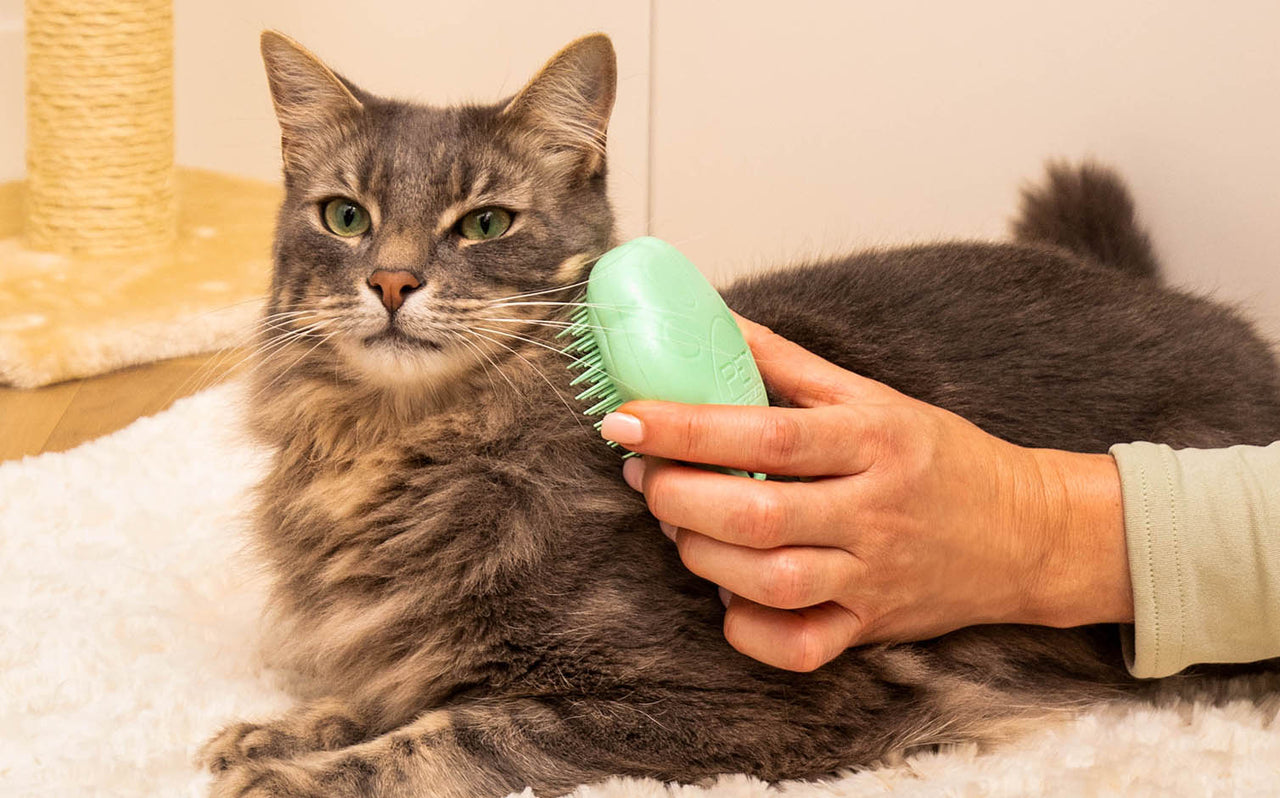Cats are known for being super clean animals - but that doesn’t mean that grooming your cat isn’t important. Whether you’ve got a British Shorthair, a Persian longhair or a fluffy American bobtail, keeping your kitty’s coat cute should be top priority as a cat owner. Not sure where to start? We’ve got all the answers in our Cat Grooming 101 Guide.
Why is Grooming Important?
You might think that grooming is simply about keeping your cat looking its fine feline self, but the benefits are way more than fur deep!
Every time you groom your cat, you’re helping to remove parasites, like fleas or ticks. These parasites can not only cause irritation, itchiness and discomfort, but they can also lead to diseases that are really harmful for animals.You also remove dead skin cells, shed hair and stimulate sebum production in the process, all of which will help keep your cat’s skin and fur healthy (not dissimilar to what our Scalp Exfoliator and Massager can do for you!)
Of course, you also want to groom your cat regularly to keep mats and tangles at bay. A matted coat not only looks bad, but it can cause a lot of pain and discomfort for your furry friend. Another benefit of keeping on top of your cat’s coat is reducing how much they shed around your house! If you’d like to keep that new sofa free from cat hair, make sure you’re grooming regularly - it also reduces the risk of fur balls!
Equipment You’ll Need
To get started with grooming your cat - you need the right toolkit.
Firstly, you of course need a great brush. Our Cat Grooming Brush is ideal because it can both detangle and de-shed at the same time. The long teeth gently detangle mats and knots, whilst the shorter teeth remove excess hair and smooth your cat’s fur. The handy palm-friendly design makes it easier than ever to groom and bond with your feline friend - and for them it feels like a relaxing massage!
This Cat Grooming Brush is perfect for short to medium fur, but if you are dealing with a long-haired cat who is prone to matting - investing in a mat splitter can also be a good idea. You can find them in most local pet stores and they help to detangle the worst mats around - which could be useful if your cat hasn’t been groomed in a long time.
Lastly, you might also find some grooming scissors and tweezers helpful to have on hand, just in case you need to cut any excess hair away or remove any irritating ticks you may find in the fur. Now you’ve got all the right equipment, it’s time to get your groom on.
Step 1: Remove the Tangles
It wouldn't be a Tangle Teezer guide if we didn't start with a bit of detangling - but before you even begin to groom, make sure your cat is comfortable. You should let them smell the brush and rub up against it on their own accord, so they can get used to the feeling. This will help your cat feel calmer so you can groom them with confidence!
Once your cat is down with the grooming plan, you can locate any mats or knots and start to detangle them. Much like you would with your own hair, we recommend starting at the tip of the tangle and moving up to the root, so you don’t make the tangle worse. If the mat is really bad, this is where you might want to use a mat separator, but usually the long teeth of our Cat Grooming Brush will do the trick, without pulling too much of your cat’s fur out in the process!
Once you have removed any large knots, you can give your cat a nice relaxing brush to smooth its fur and remove any shed hairs - which will help to prevent mats in the future. A good piece of advice is to start off with your cat’s back (as this is their favorite place to be groomed!) and then work your way around to more sensitive areas like the stomach, legs and head. Leave yourself plenty of time to groom your cat so it’s a relaxing experience for you both - and if they show any signs of discomfort, stop and give them a breather before continuing.
Step 2: Trim Nails
Once you’ve finished grooming their fur, it’s time for your cat to get its nails did! Luckily they don’t have to go to a salon for a manicure, as you can easily trim your cat’s claws at home.
Your cat’s nails are really important for them - they use them to climb trees, defend themselves and mark their territory - but you need to keep them short and blunt so they don’t accidentally scratch someone.
Now, cats don’t love getting their nails trimmed and some people like to wear rubber grooming gloves to protect themselves. Whilst your cat would never intentionally want to hurt their human BFF, there’s a chance you could get a little scratch during the process, especially if their claws are super long.

A good technique for trimming cat claws is to place their paw on a solid surface or grooming table. Take your grooming scissors and place one of their paws on the table. Then take each toe one by one and hold it between your thumb and forefinger. Use the scissors to trim about a third of the way down and make sure they’ve got a nice blunt finish so even if they do occasionally scratch out - they won’t be able to harm you or anyone else!
Step 3: Bath Time!
If you thought nail trimming was the least fun part of grooming your cat, just wait until bath time. Cats are renowned for not liking water, so can be real divas when it comes to bathing them. Luckily, they are super clean animals, so you don’t need to bath them that often. Most vets recommend every 6-8 weeks, but obviously if they are an outdoorsy cat that gets into all sorts of mischief, you might have to bathe them more regularly.
Similarly to humans, the breed of cat you have and the type of fur and skin they have also makes a difference to how often you bathe them. For example, hairless breeds like Sphynx cats require regular baths as they produce excess oils. If you are unsure about how often you should be bathing your cat, definitely check in with your vet.

When it comes to bath time - make sure you have everything you need to hand - rubber grooming gloves, a towel, shower head and of course some pet shampoo that is created for cats. Never use human shampoo or soaps as it could irritate their skin and cause rashes and irritation.
To stop your cat panicking in the bath a hot tip is to place a towel in the bottom of the tub so they have a textured surface to grip to. Then the trick is to be as quick as possible whilst making sure you are thorough. Wet them overhead with the showwer before rubbing shampoo into them. Make sure you rinse really well (before they inevitably try to make an escape!) and then dry them thoroughly with a towel.
Step 4: Ear Cleaning
A final step in your pet's grooming plan is to clean their ears. We recommend doing this once they are relaxed (so probably not straight after a bath!) Wait until they are chilling out with you on the sofa and then subtly take a look in their ears, to see how they are doing.
Again, with cats being so clean, you don’t need to wash their ears regularly. Check them out once a week and if they are a pale, pink color and looking clean, they are probably doing just fine. However, if you notice any dirt, a buildup on ear wax or signs of infection, you should give them a good clear out.

You can buy cat ear cleaner from your local pet store, and apply it with a cotton bud, gently massaging the base of the ear for around 30 seconds - just like you would with your own ears! The process of cleaning a cat’s ears is pretty simple, but you might need someone around to help hold them in place and tip their head to the side whilst you do it. If no one is available to support you, you can try wrapping them in a towel so that they can’t wriggle away - or scratch you - whilst you’re completing this final important step of grooming them.
We love cat’s for being low maintenance - and their grooming routine is no different, especially with our Cat Grooming brush, which makes it easier than ever! Try to give them a brush about once a week, or daily if they are long-haired. Not only will it help keep them healthy and happy, but you’ll enjoy some special bonding moments so they will be your feline friend for life!









